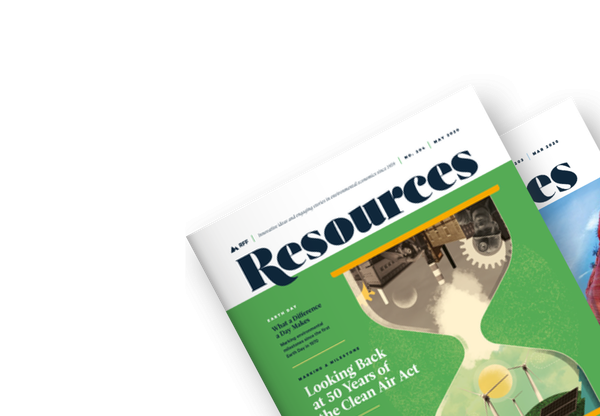Twice a month, we’re compiling the most relevant news stories from diverse sources online, connecting the latest environmental and energy economics research to global current events, real-time public discourse, and policy decisions. Keep reading, and feel free to send us your feedback.
Here are some questions we’re asking and addressing with our research chops this week:

If the Trump administration rolls back incentives for electric vehicles, what would the costs and benefits be for Americans and society?
The budget reconciliation bill includes proposed annual registration fees on electric vehicles (EVs) of $250 per year for new EVs and $100 per year for hybrids. The fee adds to the potential expenses incurred by EV owners from other reversals of EV incentives—the bill also includes a provision to phase out consumer tax credits for EVs, and President Donald Trump signed joint resolutions of Congress that revoke a waiver which had allowed California to phase out the sale of gasoline-fueled vehicles. In a new installment of the If/Then policy analysis series, Resources for the Future (RFF) Fellow Beia Spiller and Senior Fellow Joshua Linn analyze the impact of removing these incentives on EV manufacturers, consumers, and the environment. “If we add up all the benefits and costs, we find that a reversal of EV policy would have the overall effect of imposing about $33 billion in costs on total societal well-being,” conclude Spiller and Linn.
How can states ensure that rural and other underserved communities can access electric vehicle chargers, now that federal funding to expand charging-station coverage has been put on hold?
Plans among US states to expand EV charging infrastructure are in limbo since the Trump administration froze funding from the National Electric Vehicle Infrastructure (NEVI) Formula Program. Created under the 2021 Bipartisan Infrastructure Law, NEVI allocates grants to help states build charging networks, particularly in rural and underserved areas. In Wisconsin, Dane County (the location of the state capital) intended to use NEVI dollars for network expansion. With those funds now on hold, uncertainty surrounds the timing for when construction of charging stations can move forward, though the county remains committed to completing these projects. Wisconsin is among 16 states that are suing the administration for the funding freeze, claiming that the government is not authorized to withhold congressionally appropriated funds. As federal support dwindles, the responsibility for investing in EV charging may fall largely on states. In a Resources magazine article, RFF Fellows Beia Spiller and Suzanne Russo consider how states can maximize the social and economic benefits of their investments in EV charging stations. “With input from communities and policies grounded in research, states can move the needle toward achieving not just a decarbonized transportation sector, but also their broader economic and social goals,” say Spiller and Russo.

Expert Perspectives
In Focus: Wildfire Risks and Jobs
Communities are growing in areas where development meets undeveloped land, known as the wildland-urban interface—areas which also happen to be especially vulnerable to wildfires. Jobs and commercial development also are on the rise in these high-risk areas, though the risks associated with those types of growth are not as well understood. In a new In Focus video, RFF Senior Fellow Margaret Walls discusses her research on this job growth and what the trend means for building community resilience to extreme weather events.
Update: Further Reductions in Oil and Gas Royalty Rates Risk Larger Losses in Federal Revenues
Oil and gas companies pay the federal government royalties—a share of revenues—in exchange for the right to drill on public lands. The natural resources provisions of the federal budget reconciliation bill, which was passed by the House of Representatives on May 22 and now is being reviewed by the Senate, reduce these royalty rates by 25 to 33 percent. These changes are expected to reduce federal revenue significantly. In a recent blog post, RFF Fellow Brian C. Prest modeled the estimated costs of these changes, as incurred by the federal government and states. The projected costs can be explored using an interactive data tool in the blog post.
“I estimate that these cuts will lead to $6 billion in losses to the federal government between 2026 and 2035, with growing annual losses averaging nearly $3 billion per year in 2036 to 2050,” says Prest. “In addition, the royalty cuts will lead to lost revenue for oil- and gas-producing states of a similar order of magnitude, so long as the royalty cuts are in effect. New Mexico bears the brunt of lower royalty rates in both the near and long term because this region is the locus of most of the new development that would be affected by federal leasing changes. The state stands to lose about $2 billion between 2026 and 2035, and an additional $5 billion between 2036 and 2050.”
Resources Roundup

Upcoming Event: Critical Minerals Research Lab Conference
Last year, RFF Fellow Beia Spiller—with professors and researchers at Carnegie Mellon University, Stanford University, and Colorado School of Mines—established the Critical Minerals Research Lab. The lab provides a forum of interdisciplinary collaboration for PhD students studying critical mineral policies for the clean energy transition. In an upcoming virtual conference on June 26–27 hosted by RFF, lab students will showcase their research on topics that include the community impacts of mining, sustainability, and alternative forms of mineral extraction. Each presentation will be accompanied by a discussion led by an academic, policy, or industry expert. Register for the event.
RFF Modeling Informs a Tribal Nation’s Energy Development Decisions
Many of the Tribal Nations and Alaskan Native entities in the United States are major producers of coal, oil, and natural gas; these communities face unique challenges in navigating the rapidly changing energy landscape. The Southern Ute Indian Tribe, located in southwestern Colorado, relies heavily on natural gas and oil production to support public services. In their new working paper, RFF researchers Daniel Raimi, Brian C. Prest, and Alexandra Thompson collaborated with the Southern Ute Indian Tribe to examine potential energy futures for the Tribe. Their modeling considered strategies to ensure access to affordable and reliable energy through clean energy development and existing fossil fuel resources.
Transforming Cap and Trade: Aligning Pollution Markets with Public Health Goals
Air pollution is the leading environmental cause of death and disease globally. Most policies regulate pollutants separately, but pollutants can interact and become more harmful through a process called dose addition. In a new issue brief, RFF researchers Justin Kakeu, Ethan Ziegler, and Brandon Holmes explore the benefits of a policy that regulates the production of multiple pollutants together, rather than single pollutants independently. The authors also discuss how multipollutant regulatory programs could more accurately reflect how air pollutants mix in the environment and significantly improve air quality and public health outcomes.
Rooftop Solar Could Reduce Energy Prices and Tackle Energy Insecurity
Energy insecurity, or the inability to access or afford sufficient energy to meet basic household needs, affects about one in four US households. This issue is compounded by increasing retail electricity prices throughout the United States. Madeline Yozwiak, a PhD candidate studying energy policy and renewable energy transitions at Indiana University Bloomington, joined Resources Radio this week to discuss how rooftop solar technology could help alleviate rising energy costs for households in the United States. “We find that households that have rooftop solar are more likely to be able to pay their electricity bill. They’re less likely to be disconnected,” says Yozwiak.
Air Purifiers in Schools Reduce Absences and Improve Air Quality
Children living in areas with poor air quality often experience increased school absences, which has negative consequences for their learning outcomes and educational opportunities. A new working paper from the RFF-CMCC European Institute on Economics and the Environment evaluates the impact of installing portable air purifiers in classrooms to improve indoor air quality. Their study—conducted in Milan, Italy, a city known for having some of the highest air-pollution levels in the world—reveals that installing air purifiers in classrooms significantly reduces pollution levels and school absences.

🎨 Climate in the Culture 🎵

Source: DC/DOX
The third annual documentary film festival in Washington, DC, DC/DOX, returned this past week with a wide-ranging lineup of films, many of which centered on the mystery and complexity of the natural world—from murmurations of shorebirds in England to a contemplative history of the Everglades. One film, Vs. Goliath: Appalachia, spotlighted the social and environmental consequences of large-scale infrastructure projects. This documentary, which premiered on June 13, follows a grassroots movement led by a US Army veteran from Appalachia who mobilizes his community to push back against a pipeline project which threatens the land that he considers home.







